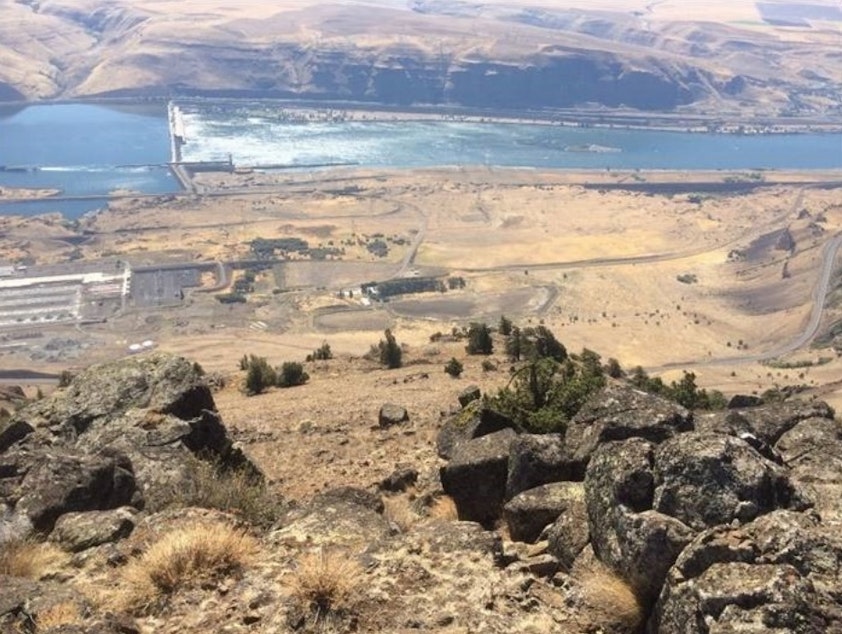Goldendale energy project would harm tribal resources, environmental impact statement finds

The Goldendale Energy Storage Project would significantly impact tribal cultural resources – with no ways around those impacts. Those are the findings of a study on the ways the renewable energy project could harm the environment.
The Washington State Department of Ecology released its final environmental impact statement Wednesday after almost a year of studying concerns about the project raised by tribes, other state agencies, citizens, and advocacy groups.
In its final statement, the department called the harms to tribes significant, unavoidable and adverse.
The statement also found potential harm to plants and wildlife, including golden eagles, little brown bats and smooth desert parsley. However, planners could account for any loss of habitat or mortalities the project causes through mitigation measures like wildlife deterrents and additional land purchases for wildlife habitat.
The statement found no other significant impacts to water resources or aquatic species.
Sponsored
The final environmental impact statement will help guide Klickitat County, state and federal agencies as they consider permits for the project, said Emily Tasaka, a spokesperson for the Department of Ecology.
“The environmental impact statement is supposed to be scientific, comprehensive, objective,” Tasaka said. “It’s not supposed to determine whether or not the project moves forward.”
If built, the Goldendale Energy Storage Project would be the largest project of its kind in the Pacific Northwest, providing 1,200-megawatts of electricity on demand, the equivalent of roughly 12 hours of electricity for people living in a city the size of Seattle.
The project would work like this: A reservoir would be built high atop Goodnoe Hills on private land in south central Washington.
More than 2,000 feet below, a second reservoir would stretch across a small section of a former aluminum smelter site.
Sponsored
Concrete or steel-lined tunnels burrowed into the sloped hillside would connect the two reservoirs.
The reservoirs would act as batteries, pumping water up the hillside when there is excess energy and storing the water until there is more demand on the grid. When it’s needed, water would be released into the tunnels and travel through turbines into the lower reservoir, helping to fulfill the region’s power needs when the wind isn’t blowing or the sun isn’t shining.
The Goldendale project would make up one-fifth of the region’s need for energy storage, said Erik Steimle, vice president of project developer Rye Development, in an earlier interview.
The Northwest will need more energy storage as more renewable energy projects come online, Steimle said.
“There are huge areas of the U.S. that are grappling with how they're going to transition to renewables, and how they're going to build storage,” Steimle said. “Those areas don't have the geology or the geography to support this type of resource like in Washington.”
Sponsored
While the natural geography makes this site a perfect fit for the Goldendale project, it also makes this site sacred to tribal members.
To the Ka-milt-pah members, or the Rock Creek Band of the Yakama Nation, Goodnoe Hills is a sacred area known as Put-a-lish. During the Ice Age Floods more than 15,000 years ago, the height of these hills protected Ka-milt-pah members from water that cascaded down the gorge.
“This whole area is really sacred from the bottom all the way to the top,” said Ka-milt-pah member Elaine Harvey in an earlier interview.
Now, traditional plants and medicines grow in the area. Tribes also raised concerns over potential visual changes in the landscape that could impact cultural and spiritual practices.
Project developers proposed several ways to lessen the impacts to tribes, including allowing access to areas where tribal members gather roots, using vegetation to hide any visual impact and recovering and curating artifacts to display at a tribal museum.
Sponsored
However, the Yakama Nation, Confederated Tribes and Bands of the Umatilla Reservation and Warm Springs Confederated Tribes of the Warm Springs repeatedly have said no mitigation measures would help, according to the final environmental impact statement.
According to a 2021 Yakama Nation Tribal Council Resolution, “The proposed pump storage development violates the Yakama Nation’s inherent sovereignty and Treaty-reserved rights through direct, permanent, and adverse destruction of nine Traditional Cultural Properties of religious and ceremonial significance.”
In addition, according to the Council’s resolution, eliminating and reducing access to food and medicine gathering “results in an irreplaceable loss of cultural resources.”
Next, the project must receive several permits, including a water quality permit from the Department of Ecology, which the department expects to make a decision on by May 2023. [Copyright 2022 Northwest News Network]
